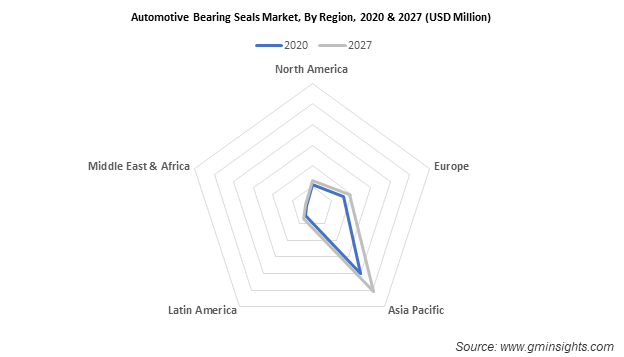Home > Automotive > Automotive Parts > Exterior Parts > Automotive Bearing Seals Market
Automotive Bearing Seals Market Analysis
- Report ID: GMI5150
- Published Date: Nov 2021
- Report Format: PDF
Automotive Bearing Seals Market Analysis
The HCV vehicle segment is predicted to generate around USD 60 million revenue by 2027. The increasing penetration of bearing seals in luxury buses and coaches, mainly in emerging countries, will spur the industry growth. The growing road transport and logistics industries across Asia Pacific and Latin America will fuel the demand for HCVs. However, increasing requirements for HCVs due to high ground clearance and payload capacity for passengers & cargo transport in multiple terrain conditions are estimated to positively impact the market demand.
The transmission segment is expected to account for about 15% of the automotive bearing seals market share by 2027. Various types of bearings are used together in a component/ equipment. The lubricating oil in the bearing installed in transmission components gets contaminated from dust and materials that wear from gears. The bearings need to be resistant to such contaminants to ensure proper functioning. Since leakages and contaminations are major reasons for seal failures, the retention of fluids within the system and the exclusion of external contaminants are key concerns. Sealing designs include conventional shaft seals with garter springs and seals with low-friction elastomer sealing lips, depending on the applications and operating conditions.
The oil seal segment is likely to surpass more than USD 450 million by 2027. Oil seals are mostly used in transmission, steering, and gear applications. Oil seal is also referred to as dirt, fluid, or grease seal and is mostly used for retaining oil or grease in a housing or case. Oil seals close the space between moving and stationary parts in a bearing, preventing the escape of lubricants. Another critical function of an oil seal is to prevent harmful containments from entering the automotive bearings.

Europe automotive bearing seals market demand is set to reach over 350 million units by 2027. This can be primarily attributed to the large automotive production across the region. The ongoing COVID-19 pandemic slowed down the market owing to lockdowns in various European countries including the UK, France, and Italy, however, despite the forced lockdowns, the Hybrid Electric Vehicles (HEV) observed substantial growth. For instance, according to the European Automobile Manufacturers Association (ACEA) report for 2020, hybrid electric vehicles sales in Europe were about 1.1 thousand units.

